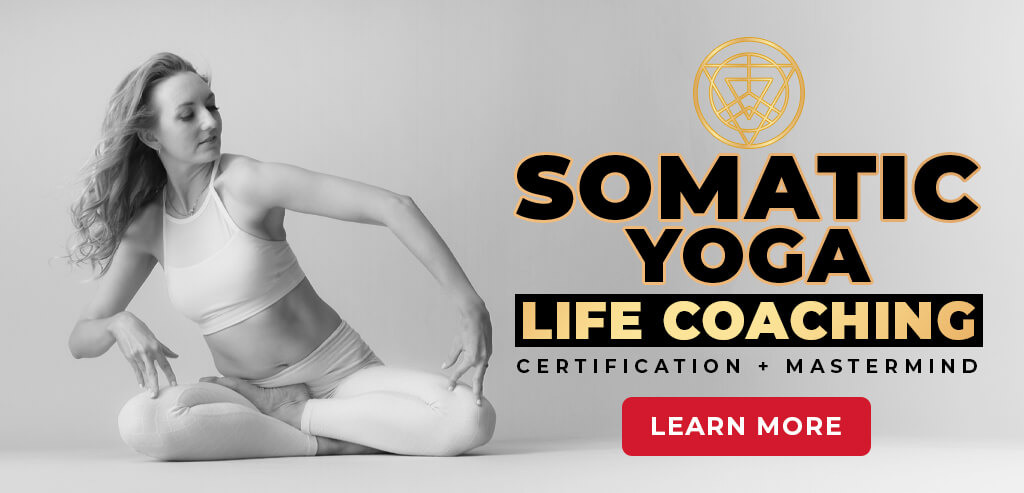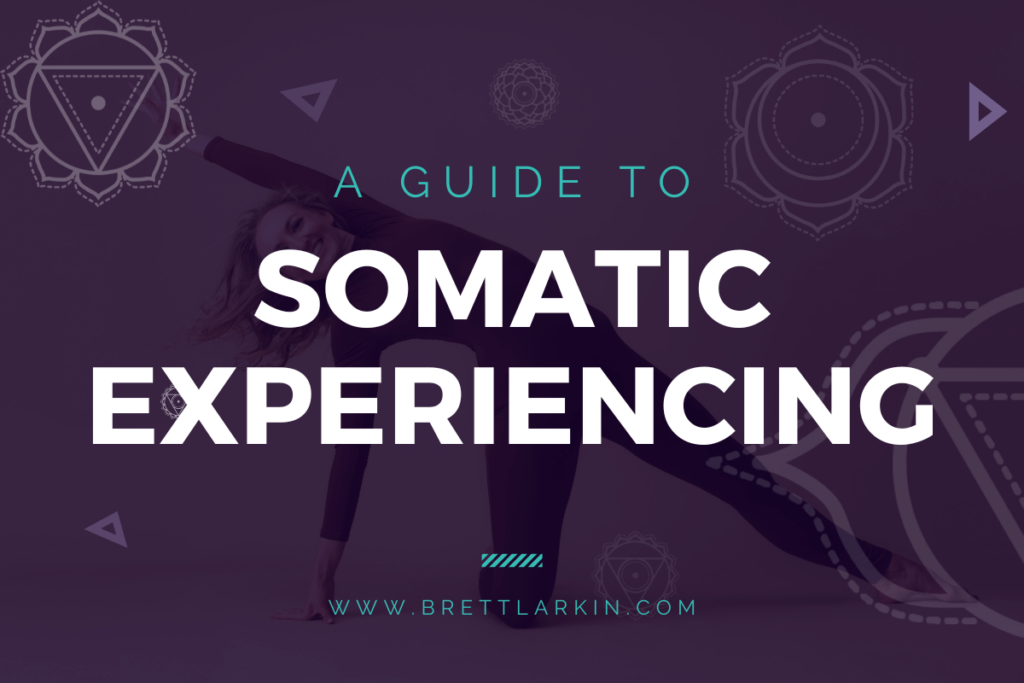For most of us, somatic experiencing feels like a wildly new experience.
In our go-go-go culture, stress is rampant and everywhere.
Because of this, many of us feel uncomfortable sensations in our body that we’d rather ignore.
However, pushing down our bodily sensations, numbing them out, and pushing ourselves isn’t the best road to healing trauma.
If you’ve experienced trauma symptoms, chronic pain, muscle tension, or your nervous system feels fried, then somatic experiencing is something you want to try out. Especially if you’ve been diagnosed with posttraumatic stress disorder.
This healing technique is rooted in indigenous healing practices and is the best trauma therapy around. It will improve your mental health and stress response.
So, what is somatic experiencing?! I’m so glad you asked…
What Is Somatic Experiencing?

Somatic Experiencing (SE) is a therapeutic approach developed by Dr. Peter Levine that aims to address and resolve the symptoms of trauma, stress, and emotional imbalances stored in the body.
Unlike traditional talk therapy that primarily focuses on verbal processing, somatic experiencing recognizes the profound impact of trauma on the nervous system and seeks to restore balance by directly engaging with bodily sensations and responses. Think: healing through the body, not just the mind.
At its core, SE acknowledges that traumatic experiences can become trapped in the body, leading to a dysregulated nervous system and a myriad of physical and emotional symptoms, like anxiety symptoms, psychological symptoms, stress disorders, and PTSD symptoms.
In somatic experiencing sessions, you are guided to gradually reconnect with your bodily sensations, allowing you to safely process and release unresolved trauma.
Through gentle exploration and mindful awareness, you learn to track sensations, emotions, and impulses without becoming overwhelmed.
SE practitioners use techniques like grounding exercises, breathwork, and gentle movement to support you in renegotiating traumatic experiences, restoring a sense of safety, empowerment, and resilience. This works even for treating PTSD.
By addressing trauma at the level of the nervous system, somatic experiencing honors the innate wisdom of the body and promotes lasting transformation, especially in recovery from a traumatic event or ongoing traumatic stress.
Somatic awareness is the starting place for all healing to happen through somatic experiencing treatment.
Whether it’s a perceived life threat or healing from a sexual or physical assault, treating trauma consistently helps people reorganize their traumatic visions, cumulative stress, and ongoing fear so they can develop increasing tolerance to stress and heal their trauma history.
If you’re ready to start healing trauma, somatic experiencing is like body psychotherapy which turns on the human animal’s innate ability to release traumatic stress and restore balance.
Benefits Of Somatic Experiencing

SE offers a wide array of benefits if you’re seeking healing from trauma, stress, and emotional dysregulation. Peter Levine found that through gentle exploration of bodily sensations and mindful awareness, SE facilitates the release of stored trauma and promotes a sense of safety, resilience, and empowerment.
To be honest, any person in the modern world can benefit from somatic therapy. However, if you suffer from post traumatic stress disorder, then consulting with a somatic therapist or other professional might be supportive for your trauma symptoms. Body psychotherapy is a great solution.
There are lots of benefits of somatic yoga if you’re looking for something a little more intuitive and low key.
The benefits of somatic therapy extend far beyond symptom reduction, although that’s a main component…
Stress Reduction and Reduction in PTSD symptoms.
Somatic techniques help regulate the autonomic nervous system, reducing the physiological and psychological effects of stress.
Research published in the Journal of Traumatic Stress proves how somatic techniques are good for reducing symptoms of PTSD and improving overall well-being.
Improved sleep quality.
When you’re able to release a traumatic memory, physical symptoms improve. For many of us, stress leads to hyped up nervous systems and insomnia or disturbed sleep patterns.
The somatic experiencing method is a great way to improve the quality of your sleep!
Emotional Regulation and Less Anxiety and Depression.
By reconnecting with bodily sensations and learning to track internal experiences, you develop greater emotional regulation skills.
SE fosters resilience and the ability to navigate challenging emotions with greater ease and self-awareness.
Panic attacks can be reduced and stress related disorders can be treated with somatic psychology. Even acute stress is known to lessen when SE is used.
Enhanced sense of safety and empowerment.
Whether it’s natural disasters, invasive medical procedures, emotional abuse, birth trauma, or being stuck in fight flight or freeze, trauma always has two core elements: a feeling of loss of safety and lack of power.
When you start practicing other techniques to soothe your thwarted survival energy, you’ll feel more in tune with your innate nature, and therefore, more safe and empowered.
Improved Relationships.
When you’re able to hold yourself in grace, you can do the same for others. SE enhances interpersonal relationships by promoting empathy, and authentic connection.
As you heal from past trauma and move through somatic healing, you are better equipped to cultivate healthy, fulfilling relationships. Your psychological symptoms reduce, traumatic stress disorders become manageable, and your mental health improves—which allows you to be available for connection with the significant people in your life.
Enhanced Body Awareness.
The somatic experiencing method, as designed by Peter Levine, helps you gain greater awareness of your bodily sensations and responses.
This heightened body awareness allows you to recognize and release patterns of tension and stress, as well as traumatic memories, traumatic shock, and suppressed emotions.
Through gentle exploration of bodily sensations and mindful awareness, you can experience profound transformations and reclaim a sense of wholeness and vitality.
Experience My Somatic Yoga Workshop (usually $67) FREE!👇

What Somatic Experiencing Can Help With

There are so many ways somatic therapies can help you. From the body’s perspective, any type of SE, especially practices rooted in Peter Levine and his research, is welcome. The body wants to release the trauma!
Most of us experience stress physiology as a self protective act. However, the greatest thing you can do is work through difficult bodily sensations, rooted in science trauma, to improve your mental health. These practices help other stress disorders too, and can even help you overcome a perceived life threat.
So, what can SE do for you? Here’s a few things…
- Trauma Recovery: Whether it’s a single traumatic event or complex trauma stemming from childhood experiences or early developmental attachment trauma, somatic techniques can help you renegotiate your relationship with past trauma and reclaim a sense of safety and empowerment, much better than something like exposure therapy or physical therapy. Peter Levine studied this for many years, and it’s a proven way to process any traumatic event.
- Stress Management: These techniques help regulate the nervous system, promoting relaxation and reducing the physiological and psychological effects of stress. Eventually, you will develop coping strategies to navigate stressful situations with greater resilience and ease. And your body will know how to release trauma when it happens, not store it for years to come.
- Feminine rage: I believe every human needs to have a rage ritual. Anger and rage have been suppressed for centuries, so many of us, especially women, store that in our bodies. SE can help you explore and process your feminine rage. By providing a safe space for expression and release, you’re able to navigate the complexities of anger in a healthy and empowering way – instead of taking it out on the people around you!
Take my feminine energy quiz to get a recommended practice for balancing YOUR feminine energy 👇
Somatic Therapy Techniques

These techniques recognize the interconnectedness of body, mind, and soul—and they aim to restore balance to the nervous system.
The most common and impactful somatic exercises are…
Grounding Techniques
Think savasana on the floor and big Kapha energy. Grounding techniques involve connecting with the present moment and the physical sensations of the body to anchor oneself in the here and now.
This may include practices such as mindfulness meditation, guided visualization, or sensory grounding exercises, helping you feel more rooted and centered amidst emotional turmoil or distress.
Pendulation
Pendulation involves gently oscillating between sensations of safety and discomfort in the body, allowing you to gradually shift your experience and regulate your nervous system.
This technique helps build resilience and tolerance for distressing sensations by alternating between moments of comfort and challenge, widening your window of capacity.
Orienting
Orienting is a natural instinctual response where you scan your environment for signs of safety and danger.
In SE, orienting exercises are used to help you feel more grounded and present by engaging your senses and orienting towards safety cues in their surroundings.
This technique can help reduce overwhelm and disconnection, fostering a sense of stability in the present moment.
Somatic Tracking
Somatic tracking involves developing awareness of bodily sensations and internal experiences without judgment or interpretation.
This practice helps you tune into the subtle cues of your body, allowing you to identify areas of tension, discomfort, or activation related to trauma or stress.
By cultivating this awareness, somatic tracking allows you to be super tuned in with how your body is feeling and what needs to be released.
Titration
Do you ever feel overwhelmed when thinking about how to approach your healing? Well, you can break it into smaller chunks. Literally! Titration is a pacing technique that involves breaking down overwhelming experiences into smaller, more manageable components.
This allows you to gradually approach and process difficult material without becoming overwhelmed or re-traumatized. By titrating your experience in this way, you can safely explore and release stored trauma, without feeling like it’s too much.
With all these great techniques, where do you get started?
How to Get Started With Somatic Experiencing

Whether you’re interested in seeking therapy or exploring somatic practices on your own, here are some practical steps to help you begin:
Seeking Somatic Therapy
- Find a Certified Somatic Practitioner: Look for a licensed therapist who has completed training in somatic therapy. You can search online directories or ask for recommendations from friends and family.
- Commit to the Process: Once you’ve found a therapist you feel comfortable with, commit to the therapeutic process and attend regular sessions as recommended. Be open to exploring new techniques and approaches, and trust in the wisdom of your body to guide you on your healing journey.
How To Explore Somatic Practices on Your Own
- Educate Yourself: Start by reading books or articles (like this one!) on somatic therapy to gain a better understanding of the principles and techniques involved. Some recommended resources include “Waking the Tiger” by Peter Levine and “The Body Keeps the Score” by Bessel van der Kolk.
- Practice Awareness: Begin incorporating mindfulness practices into your daily routine to cultivate awareness of bodily sensations and emotional experiences. Take a few moments each day to pause, breathe deeply, and tune into your body without judgment or interpretation. Get on the mat and do one of the techniques above. The most important thing is to deepen your breath, get into a regulated state, then allow your body to move intuitively.
- Experiment with Gentle Movement: Explore gentle movement practices such as yin and restorative yoga, to connect with your body and release tension. Focus on moving intentionally and listening to your body’s cues, letting your intuition lead the way.
- Engage in Self-Reflection: Take time to reflect on your experiences and emotions, through journaling or expressing yourself creatively. Buy a new journal, get a new painting set, or start playing around with graphic design. Notice any patterns or themes that emerge, and consider how somatic techniques can support you in processing and integrating these experiences, especially any traumatic ones.
Whether you choose to seek therapy or explore somatic practices on your own, remember to approach the process with patience, compassion, and self-care.
Give yourself grace. Trust in your body’s innate capacity to heal, and honor the wisdom it holds as you embark on your journey of somatic healing.
Common Questions About Somatic Techniques

Here are some common questions I get asked by students about somatic techniques.
What is an example of somatic therapy?
Somatic therapy was developed by Dr. Peter Levine. It is a body-oriented approach to healing trauma that aims to restore balance to the nervous system by addressing the physiological and emotional impacts of trauma stored in the body. Examples include any movement practice that helps release stress to heal mental, emotional, and physical symptoms. The exercises listed above are a great place to start.
What does a somatic release feel like?
A somatic release can feel different for each person, but common sensations include a sense of lightness, relaxation, and emotional release. It may feel like tension melting away from the body, muscles softening, and a deep sense of peace washing over you.
Some people may also experience tingling sensations, warmth, or a feeling of energy flowing freely through the body. Somatic releases can vary in intensity and duration, depending on your unique experiences and the nature of the trauma being processed.
How is trauma stored in the body?
Trauma is stored in the body through a complex interplay of physiological and psychological mechanisms. When a person experiences trauma, the body’s natural fight, flight, or freeze response may become dysregulated, leading to the activation of the autonomic nervous system and the release of stress hormones.
If the trauma is not processed and resolved, these physiological responses can become stuck or frozen in the body’s tissues, resulting in chronic tension, pain, and emotional distress. Somatic therapy aims to release these stored trauma responses and restore balance to the nervous system.
What does a somatic experiencing therapy session look like?
A somatic therapy session typically begins with establishing a safe and supportive environment.
When I lead a somatic yoga session, the first thing we do is decide whether we need to release energy or immediately get into a relaxed state. I might do a Vinyasa flow to release pent up nerves, then move into a grounding child’s pose to calm my breath and relax, finally transitioning into savasana.
If you work with a therapist, they may ask you to describe any physical sensations or emotions you are experiencing in the present moment. Using gentle guidance and somatic techniques, such as grounding exercises, breathwork, and mindful awareness, the therapist helps you connect with your body and explore sensations related to past trauma.
Throughout the session, you and the therapist work collaboratively to process and release stored trauma. And the same is true for an Embodied Yoga session. It’s a collaborative, supportive process to help you heal.
Final Thoughts
By honoring the wisdom of the body and addressing trauma at its roots, somatic healing empowers you to reclaim your sense of safety, resilience, and power.
Whether you choose to seek therapy with a certified somatic practitioner or explore somatic practices on your own, remember that healing is a journey that unfolds over time.
Trust in your body’s innate capacity to heal, and embrace the support and resources available to you along the way.
If you’re ready to embark on your journey of somatic healing, take the first step today by reaching out to a qualified therapist or exploring somatic practices that resonate with you.
If you’re ready to go deep into embodiment, I want to invite you to Embodied Yoga Life Coaching. This training is an intensive deep dive into your own personal development. You’ll also benefit from the friendship, expertise, networking, and support of like-minded professionals in your handpicked cohort.
Next Steps
- Take a deep dive into embodiment and somatic yoga with my Somatic Yoga certification program.
- If you’re interested in practical kriya yoga as a way to improve your daily life and relationships, check out my Yoga for Self Mastery course.

FREE Embodied Yoga Workshop (usually $67) Somatic Techniques & Cord Cutting Ritual

YOU MIGHT ALSO LIKE
- The Perfect Yoga Practice For Your Menstrual Cycle Energy Levels
- Enhancing Your Practice: The Benefits of Yoga and Nature Connection
- Gentle Somatic Yoga for Back Pain: Relief and Prevention Techniques
- How Somatic Yoga for Anxiety Can Help You Find Calm and Balance
- Somatic Stress Release Techniques for Emotional Balance
- Progressive Muscle Relaxation Meets Yoga for Deep Sleep
- 5 Somatic Hip Exercises For Beginners
- How To Relieve Myofascial Pain with Yoga: Heal and Prevent Muscle Tension
- Somatic Energy Healing: Techniques to Realign and Restore Balance
- How Somatic Shaking Can Release Tension and Reset Your Nervous System
- How To Create Mindful Somatic Yoga Sequences Your Students Will Love
- Somatic Yoga Poses For Every Body And Mind
- 6 Hip Openers For Emotional Release
- What Are Myofascial Release Trigger Points?
- Integrating Mind and Body: The Benefits of Somatic Bodywork









